

alma-nac

London Borough of Lambeth, United Kingdom
May 2024
Architecture design & planning
Service with Minor Environmental Footprint
United Kingdom
alma-nac is a London-based architecture studio established in 2010 by Chris Bryant, Caspar Rodgers and Tristan Wigfall. The practice has built a reputation for its imaginative yet pragmatic work. Named as one of AJ’s 40 under 40, alma-nac has won the AJ retrofit award twice as well as Regional and National RIBA awards. Much of alma-nac’s work focuses on the reuse and reimagining of existing spaces to provide more sustainable design solutions. They won the AJ Retrofit Housing award for Paxton House and are currently working on a Net Carbon Zero project for Dulwich College that reuses much of the existing structure. Central to alma-nac’s work is a participatory approach; exploring the positive impact of meaningful engagement with clients and end users. In 2023, in collaboration with other built environment professionals, alma-nac launched Design for All, They describe their practice as driven by ‘collaboration and participation’ and ‘an appetite for experimentation’ with a ‘social agenda to broaden the remit and democratise the output of the profession’.
Overall B Impact Score
Governance 18.5
Governance evaluates a company's overall mission, engagement around its social/environmental impact, ethics, and transparency. This section also evaluates the ability of a company to protect their mission and formally consider stakeholders in decision making through their corporate structure (e.g. benefit corporation) or corporate governing documents.
What is this? A company with an Impact Business Model is intentionally designed to create a specific positive outcome for one of its stakeholders - such as workers, community, environment, or customers.
Workers 29.4
Workers evaluates a company’s contributions to its employees’ financial security, health & safety, wellness, career development, and engagement & satisfaction. In addition, this section recognizes business models designed to benefit workers, such as companies that are at least 40% owned by non-executive employees and those that have workforce development programs to support individuals with barriers to employment.
Community 19.0
Community evaluates a company’s engagement with and impact on the communities in which it operates, hires from, and sources from. Topics include diversity, equity & inclusion, economic impact, civic engagement, charitable giving, and supply chain management. In addition, this section recognizes business models that are designed to address specific community-oriented problems, such as poverty alleviation through fair trade sourcing or distribution via microenterprises, producer cooperative models, locally focused economic development, and formal charitable giving commitments.
Environment 20.8
Environment evaluates a company’s overall environmental management practices as well as its impact on the air, climate, water, land, and biodiversity. This includes the direct impact of a company’s operations and, when applicable its supply chain and distribution channels. This section also recognizes companies with environmentally innovative production processes and those that sell products or services that have a positive environmental impact. Some examples might include products and services that create renewable energy, reduce consumption or waste, conserve land or wildlife, provide less toxic alternatives to the market, or educate people about environmental problems.
What is this? A company with an Impact Business Model is intentionally designed to create a specific positive outcome for one of its stakeholders - such as workers, community, environment, or customers.
Customers 3.7
Customers evaluates a company’s stewardship of its customers through the quality of its products and services, ethical marketing, data privacy and security, and feedback channels. In addition, this section recognizes products or services that are designed to address a particular social problem for or through its customers, such as health or educational products, arts & media products, serving underserved customers/clients, and services that improve the social impact of other businesses or organizations.